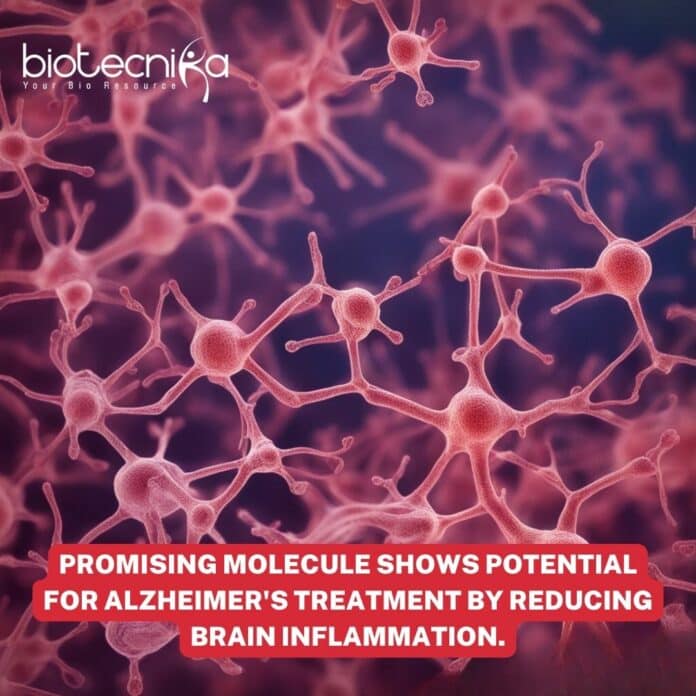Alzheimer’s Treatment Potential – Promising Molecule Shows Hope By Reducing Brain Inflammation
In the quest to find effective treatments for Alzheimer’s disease, scientists have made significant strides in targeting the amyloid-beta protein. However, addressing the issue of inflammation in Alzheimer’s has proven to be a challenging task. In a groundbreaking study conducted by researchers at the Picower Institute for Learning and Memory at MIT, a novel drug candidate has emerged, demonstrating its ability to reduce inflammation and enhance memory function in both human cell cultures and Alzheimer’s mouse models.
Understanding The study, titled “A novel molecular class that recruits HDAC/MECP2 complexes to PU.1 motifs reduces neuroinflammation,” was published in the Journal of Experimental Medicine. The study centers its attention on neuroinflammation, a frequently observed phenomenon in several neurodegenerative disorders, such as Alzheimer’s disease. The scientists were particularly interested in the PU.1 transcription factor, which plays a crucial role in regulating inflammatory gene expression in microglia, the immune cells in the brain.
A New Player: A11 Molecule The study revealed that a molecule called A11 effectively suppresses PU.1 activity by recruiting other proteins that inhibit the expression of inflammatory genes regulated by PU.1. Importantly, A11 primarily concentrates in the brain and does not interfere with PU.1’s role in blood cell production, addressing concerns about potential side effects. The Search for the Perfect Compound To identify A11, the research team screened a vast library of over 58,000 small molecules, including FDA-approved drugs and novel compounds. After rigorous testing, A11 emerged as the most potent compound in reducing inflammation and genes associated with Alzheimer’s disease regulated by PU.1. A Promising Discovery Dr. Li-Huei Tsai, the senior author of the study, expressed optimism about the findings. She emphasized that inflammation is a critical component of Alzheimer’s pathology, and A11 demonstrates the potential to reduce inflammation in human microglia-like cells and various Alzheimer’s mouse models. Additionally, A11 significantly improved cognitive function in the mice. This promising outcome suggests that A11 deserves further development and extensive testing.
Insights from Comparative Studies The researchers compared gene expression in immune cells from postmortem brain samples of Alzheimer’s patients, mouse models, and non-Alzheimer’s controls. They found significant changes in microglial gene expression in Alzheimer’s cases, with increased PU.1 binding to inflammatory gene targets being a noteworthy observation. A11’s Impact on Microglia-like Cells In laboratory experiments using human microglia-like cells derived from patient stem cells, A11 demonstrated its potential. When exposed to typical inflammatory triggers, A11-treated cells exhibited reduced expression and secretion of inflammatory cytokines. These cells also displayed fewer changes in cell shape associated with inflammatory responses. Furthermore, lipid accumulation, another indicator of inflammation, was reduced in A11-treated cells.
A Unique Mechanism A11 signifies an innovative molecule that transforms PU.1 from being a transcriptional activator to functioning as a transcriptional repressor. This transformation leads to controlled microglial inflammation, potentially mitigating excessive inflammatory responses. A Path Forward Although further testing is required before A11 can be considered an approved treatment, the research team remains hopeful. A11’s ability to cross the blood-brain barrier and remain in brain cells for an extended period is a promising indicator. A11 may complement existing treatments that target amyloid-beta, offering improved options for addressing neurodegenerative diseases.
In conclusion Promising Molecule Shows Potential for Alzheimer’s Treatment by Reducing Brain Inflammation, the discovery of A11 and its potential to reduce brain inflammation in Alzheimer’s disease is a significant breakthrough. While more research is needed, A11 could hold the key to a more comprehensive and effective approach to treating this devastating condition.



